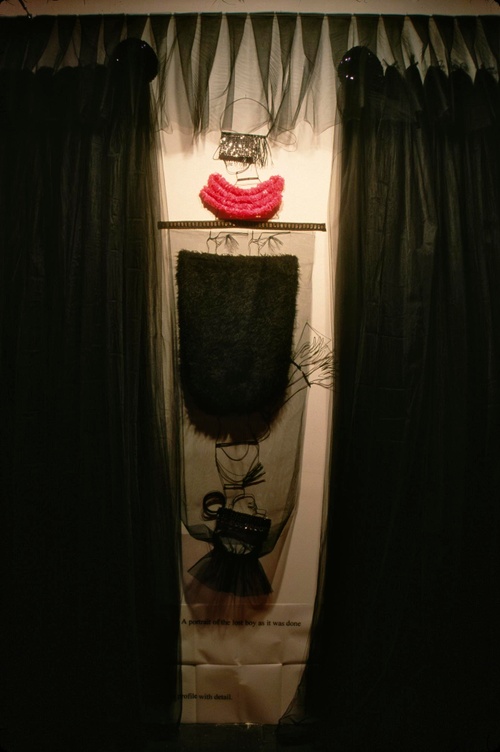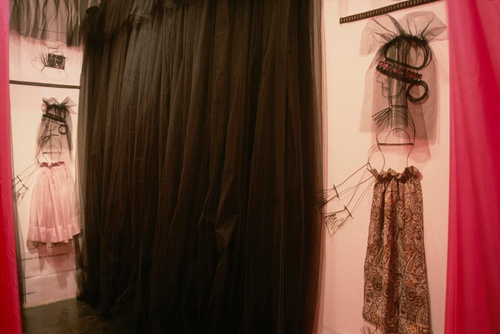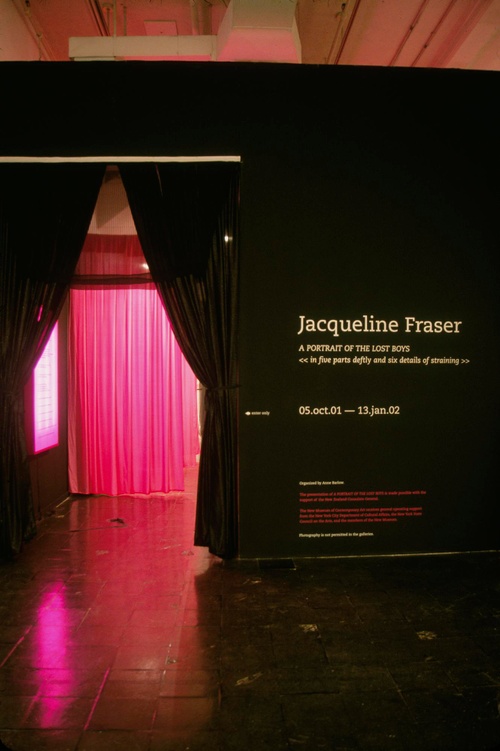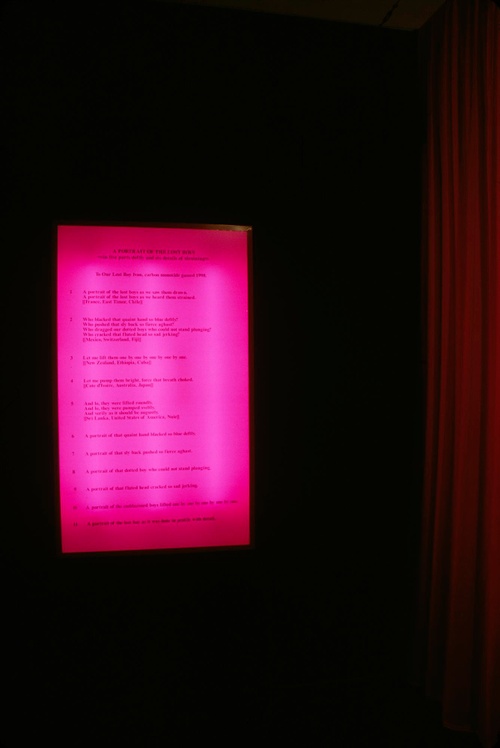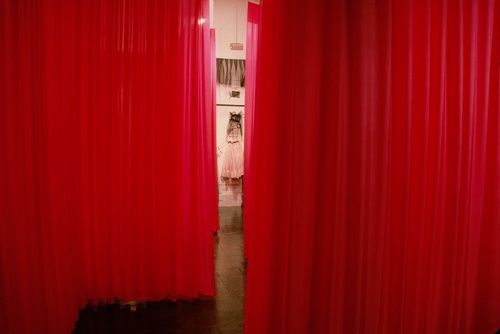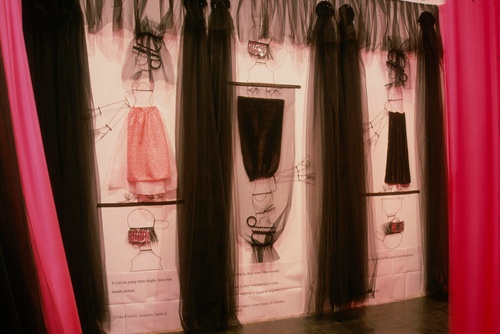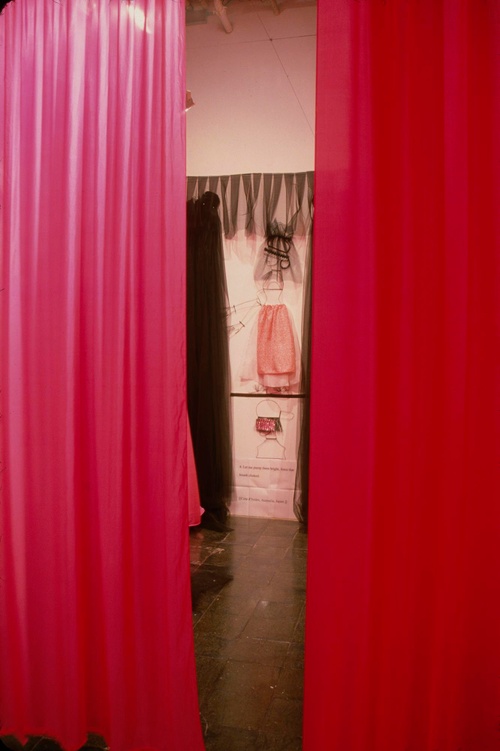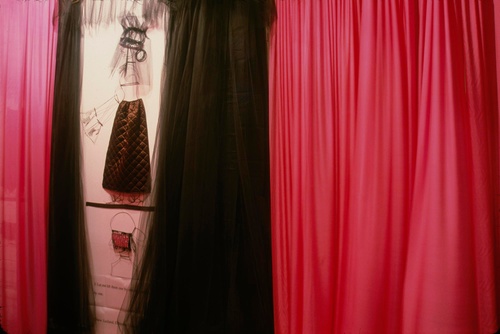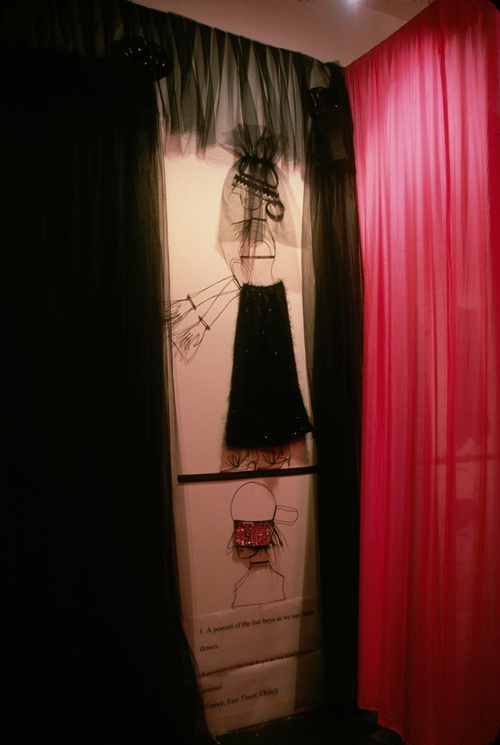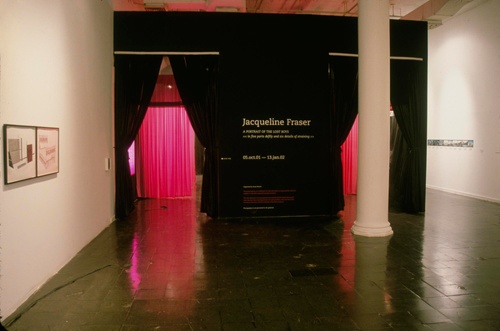Jacqueline Fraser: A PORTRAIT OF THE LOST BOYS<< in five parts deftly and six details of straining>>
Jacqueline Fraser: A PORTRAIT OF THE LOST BOYS<< in five parts deftly and six details of straining>>
Jacqueline Fraser’s installations of fabric, wire and text have the elegance of high fashion, but their beauty and fragility is deceptive. Beneath their surface appeal lies a sharp critique of our tendency to form cultural stereotypes despite the increasingly global nature of society. Fraser, who lives in Auckland, New Zealand, draws on diverse visual sources-such as rock videos, televised fashion shows, and films in many languages-to explore a range of social hierarchies and subcultures.In much of her work, she deals with the idea of someone who does not ‘fit in’ because of race, class, economic status, or culture.
A PORTRAIT OF THE LOST BOYS << in five parts deftly and six details of straining>> is the third in a trilogy of installations that began earlier this year at the Venice Biennale, Italy and continued at the Yokohama Triennale, Japan. As a group, these installations look at the way in which different cultures consider themselves superior or inferior to one another, depending, for example, on their use of language or on their perceived ‘importance’ in the world. Fraser uses different tactics to bring this to the viewer’s attention. Often, she uses several languages at once to make them equally important-as in her Venice installation where she used English, Maori and Italian texts. Similarly, as in this work at the New Museum, she names many countries in a single work to discourage a one-sided view of the world. A Portrait of the Lost Boys entices the viewer through a maze-like structure of luxurious pink silk. The drama unfolds through a series of eleven wire female figures, shrouded in black net veils, pinned above or below the heads of young boys. Despite the work’s seductive beauty, the text on the light-box reveals the underlying narrative of the horror of self-inflicted death: “To Our Lost Boy Ivan, carbon monoxide gassed 1998”. Texts under each set of figures describe acts of violence and despair that are not specific to the boys of any one country: 5 And lo, they were lifted roundly. And lo, they were pumped sveltly. And verily as it should be augustly. [[Sri Lanka, United States of America, Nuie]] Without directly casting blame, the texts also touch on the social and cultural contexts that may have contributed to these acts: 2 “Who blacked that quaint hand so blue deftly? Who pushed that sly back so fierce aghast? Who dragged our dotted boys who could not stand plunging? Who cracked that fluted head so sad jerking? [[Mexico, Switzerland, Fiji]] A Portrait of the Lost Boys continues Fraser’s examination of how societies define ‘normal’ or acceptable behavior, and the ensuing pressures that may be placed on each of us to conform. On a larger scale, she looks at how entire communities may view the behavior of others as aberrant, or even psychotic. The danger of eliminating cultural difference is expressed at its most extreme in her installation for Yokohama. Here, a disturbing subtext tells of a ‘genetic engineer’ who can enforce feelings of superiority by genetically altering someone’s cultural make-up at birth. It is impossible to read Fraser’s work one-dimensionally. Her texts and images are like a series of codes that we can never quite crack-even the titles have many associations, whether fictional or real.
The ‘Lost Boys’ may call to mind the recent study by American psychologist James Garabino on the growth of violence in American youth-or the phrase used by the international press to describe the thousands of Sudanese refugees seeking asylum in the United States since the 1980s. Alternatively, you may think of the fictional characters in J.M. Barrie’s Peter Pan, a contemporary Japanese anime character, or the 1987 cult vampire film The Lost Boys starring Kiefer Sutherland. There is no ‘right’ answer: what matters more is that in each case, the boys represent groups that are disenfranchised from the society around them. As her narratives have become more layered, the appearance of the work has become more complex over time. Two-dimensional sculptures gradually gave way to the room-sized installations she began making in 1977. These spaces-usually viewed from the entrance only-were made from unusual ribbons, braids, and other ephemeral materials that were often discarded afterwards. In 1992-93, during a residency in Paris, Fraser began to work with the more durable material of wire, creating figures that she incorporated into larger-scale pieces. Fraser has since expanded her work into walk-through architectural installations-immersive experiences that present at close hand a myriad of colored fabric, intricate wire figures, and texts.
Fashion is a primary influence. Fraser creates the kinds of structures used by designers such as Yohji Yamamoto, Comme des Garcons, and Prada-whose gorgeous, minimal or provocative clothing often takes fashion to an almost ‘sculptural’ level. The veiling and layering of fabric also defines the architecture of each space, as well as revealing-or disguising-the faces of individual figures with opaque or transparent materials. Through both her subject matter and materials, Fraser’s work intentionally crosses the divide between local and international. She uses materials that reflect the nature of each site-creating excessive ornament and richness in Venice; claustrophobic veiled figures in Yokohama; and a more pared back ‘minimalism’ in New York. Here, she selects black eyelash silk, pink chiffon, black tulle netting, and a strange 1970s braid from a store on Broadway. These materials give the work a lavish aesthetic that, on one level, sits uncomfortably with the subject matter of suicide. On closer inspection, they frame a narrative in which the last boy, presented with a garland, appears to triumph over the allure of premature death.

